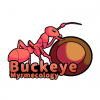

Sent from my Pixel XL using Tapatalk

This is the same species as the other specimen you posted an ID thread on; Formica integra.
There are only two other species in the Formica rufa group present in Ohio:
Edited by AntsBC, July 6 2019 - 9:32 PM.
Thanks.This is the same species as the other specimen you posted an ID thread on; Formica integra.
There are only two other species in the Formica rufa group present in Ohio:
Formica prociliata and Formica obscuriventris
We can easily rule out F. prociliata due to the fact that their queen's have stringy hairs on the sides of their mesosoma, and many other characteristics that don't match with this specimen.
We can rule out F. obscuriventris due to the fact that their queen's have small setae present on the mesosoma (a characteristic that this specimen and F. integra do not possess), a slightly rougher surface then F. integra and a somewhat differently shaped head. The distinguishing characteristic is the foremost, though.
This explanation goes for the other ID thread you posted, as well.
Please follow proper ID request formatting as obviously put at the top of the request thread.
0 members, 1 guests, 0 anonymous users